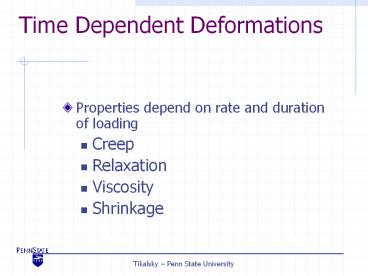Time Dependent Deformations - PowerPoint PPT Presentation
Title:
Time Dependent Deformations
Description:
Time Dependent Deformations Properties depend on rate and duration of loading Creep Relaxation Viscosity Shrinkage Review: Elastic Behavior Elastic material responds ... – PowerPoint PPT presentation
Number of Views:102
Avg rating:3.0/5.0
Title: Time Dependent Deformations
1
Time Dependent Deformations
- Properties depend on rate and duration of loading
- Creep
- Relaxation
- Viscosity
- Shrinkage
2
Review Elastic Behavior
- Elastic material responds to load instantly
- Material returns to original shape/dimensions
when load is removed - Modulus of Elasticity ds/de
- Energy and strain are fully recoverable
3
Stress Strain Curve
Modulus of Toughness Total absorbed energy
before rupture
Modulus of Elasticity
Modulus of Resilience Recoverable elastic
Energy before yield
Ductility Ratio of ultimate strain to yield
strain
4
Creep
- Time dependent deformation under sustained
loading
5
Creep Behavior
- Stress changes the energy state on atomic planes
of a material. - The atoms will move over a period of time to
reach the lowest possible energy state, therefore
causing time dependent strain. In solids this is
called creep. - In liquids, the shearing stresses react in a
similar manner to reach a lower energy state. In
liquids this is called viscosity.
6
Idealized Maxwell Creep Model
- Maxwell proposed a model to describe this
behavior, using two strain components - Elastic strain, ?1 ?/E
- Creep strain,
?
e 1?/E
e
? constant
e2
?
?
e1
time
7
Creep Prediction
- Creep can be predicted by using several methods
- Creep Coefficient
- ?creep/?elastic
- Specific Creep
- ?creep/?elastic
8
Creep Behavior changes with Temperature
Strain
Tertiary
Secondary
Primary
High Temperature
Ambient Temperature
Time
9
Creep Behavior changes with Stress
10
Relaxation
- Time dependent loss of stress due to sustained
deformation
11
Idealized Relaxation Model
- Maxwells model can be used to mathematically
describe relaxation by creating a boundary
condition of ,
12
Plot of Relaxation
e constant
13
Viscosity
- Viscosity is a measure of the rate of shear
strain with respect to time for a given shearing
stress. It is a separating property between
solids and liquids. - Material flows from shear distortion instantly
when load is applied and continues to deform - Higher viscosity indicates a greater resistance
to flow - Solids have trace viscous effects
- As temperatures rise, solids approach melting
point and take on viscous properties.
14
Viscous Behavior
- Energy and strain are largely non-recoverable
- Viscosity, h
- h t / dg/dt
- shear strain rate dg/dt
- h is coefficient of proportionality between
stress and strain rate
15
Shrinkage
- Shrinkage deformations occur in hydrous materials
- Loss of free water, capillary water, and
chemically bound water can lead to a deduction of
dimensions of a material - Organic materials like wood shrink and/or expand
over time, depending on the ambient environmental
conditions. - Hydrous materials like lime mortar shrink over
time. The rate of shrinkage is largely related
to relative humidity.
16
Shrinkage Mechanism
e0
e0-esh
- The loss of capillary water is accomplished by a
variety of mechanisms - Heat
- Relative Humidity
- Ambient Pressure
- Stress (mathematically included in creep)
- Shrinkage can also be related to the dehydration
of hydrated compounds CaSO42H2O (gypsum) to
CaSO4½H2O or Ca(OH)2 to CaO. This type of
dehydration is also accompanied with change in
mechanical strength properties.
17
Summary of time dependent effects
- Creep
- Relaxation
- Viscosity
- Shrinkage
- Temperature increases deformation
- Microstructure of material
- Atomic structure
- Crystalline
- Amorphous
- Bonding































